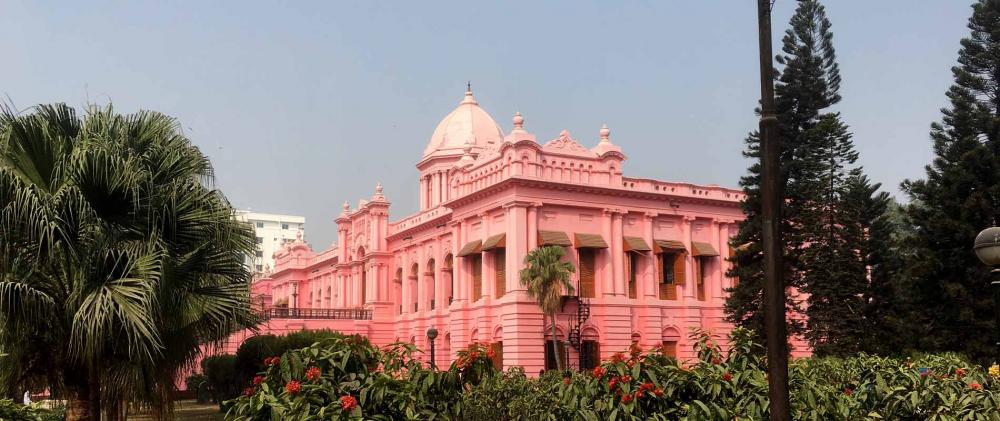
During the era of the British empire in the 19th century, under the space of 5.5-acre premises, a palace was built by Dhaka’s Nawab family, Nawab Khwaja Abdul Ghani(1813-1896) in Dhaka. This palace is very famous for its architectural identity both from inside and outside also known as the pink palace. The history of Dhaka mostly relies here upon if anyone intends to study its colonization.
In 1872. on the bank of the River Buriganga in Old Dhaka, the Bengal nawabs also called zamindars constructed this very royal residence as the main living place of the entire family. It was named after Nawab Khwaja Abdul Ghani’s son, Nawab Khwaja Ahsanullah (1846–1901). But, it is more fascinating when you will get to know that the origin of this palace was actually built in the time of the Mughal emperor which was actually a place for amusement and getting entertained in various ways.
This luxurious palace was then named Rangmahal constructed by the most amazing person of that time Sheikh Enayet Ullah, and the area was known as Kumartuli. As he was a very powerful man with a greater force, he used to bring girls from overseas or even from his own state and made them wear fancy dresses with ornaments that shine like gold. Their purpose was to entertain people in every way possible who pays for a visit in Rangmahal.

French trade center
The death of the founder of this beautiful palace, Sheikh Enayet Ullah, is still an unsolved matter which has been carried all these years from the local's mouth. One of the Mughal emperor’s specimens (known as Foujdar) got his eyes caught over a girl.
To fulfill his evil intentions he tricked Sheikh by offering an invitation and got him killed while he had his chance, but, all his(Foujdar) efforts went in vain when that very girl committed suicide. If you walk to the northeast corner of this palace you will find that space where Sheikh was buried; though in the early century it was damaged.
Afterward, Sheikh’s dearest son traded all the properties to the French and they enlarged their business which later on boomed within a short period of time, moreover, they had support from the emperor (Awrangajeb) himself. They even built “les Jalla” which is actually a big pond and a palace as a sign of their prosperity.
The arrival of Nawab Khwaja Abdul Ghani
.jpg)
But, those French traders ruled that area till the year 1757, after that they left everything and went back to their motherland owing to the defeat in the English-French war.
After 70 years, the French sold these properties in Dhaka to Khwaja Alimullah, the father of Nawab Khwaja Abdul Ghani. He did proper judgment with this property by reconstructing the old building and also making a new one which was then named “Andor Mohol” and “Rong Mohol” respectively.
You will definitely feast your eyes by this picturesque Ahsan Manzil which was the Dhaka’s Nawab Family’s living place, established in Kumartoli on the bank of the Buriganga. This Mughal-Gothic suppression is full of histories and mysteries since 1869.

The architectural measurement
The structure of this palace is mainly two-storied which faces the Buriganga river. The height of this pink palace is approximately 125.4 meters and the width is approximately 28.75 meters.
For the photogenic people, there is a ton of mind-blowing frame to capture the memories. An open terrace in the middle of both south and north with wider verandahs will make you astonishing and leave you with a WOW!!!
If you visit Rangmahal, it covers the east side of the palace and Andarmahal, the west. These two sections are the two main keys of Ahsan Manzil that attracts the visitors in Dhaka city.
Rangmahal and andarmahal

When you go inside Rangmahal, you will be mesmerized by watching the Jalshagar, crafted by ceilings of wood and a spacious drawing room. Apart from that, you will also see an old library, a stateroom and some spare rooms for guests.
You are going to find here the royal dining space where they used to have their dietary sustenance, and a multi-colored floor including white, green, and yellow tiles for Darbar Halls, where they used to discuss all those serious issues. Inside, well-furnished wooden stairs, railings made of iron, and ornamented balusters are combinedly designed in such a way that it would be hard for your eyes to blink.

National Museum of Bangladesh
You will fall in love with the marble-polished corridors and multicolored inner doors made of glass. Since the natural disasters tried to take away the real beauty of Ahsan Manjil several times, this luxurious palace held strong every time. It was declared as the National Museum of Bangladesh in 1992.
Check out our Full Day sightseeing at Old Dhaka to visit this Pink Palace at Old Dhaka.
Visiting hours of Ahsan Manzil
Summer Season (April - September)
Winter Season (October- March)
Full-Day Tour At Sonargoan (Old Capital)
National Parliament Building Tour
Tour To Old Dhaka and Sonargoan
Excursion to ManikGanj Baliati palace